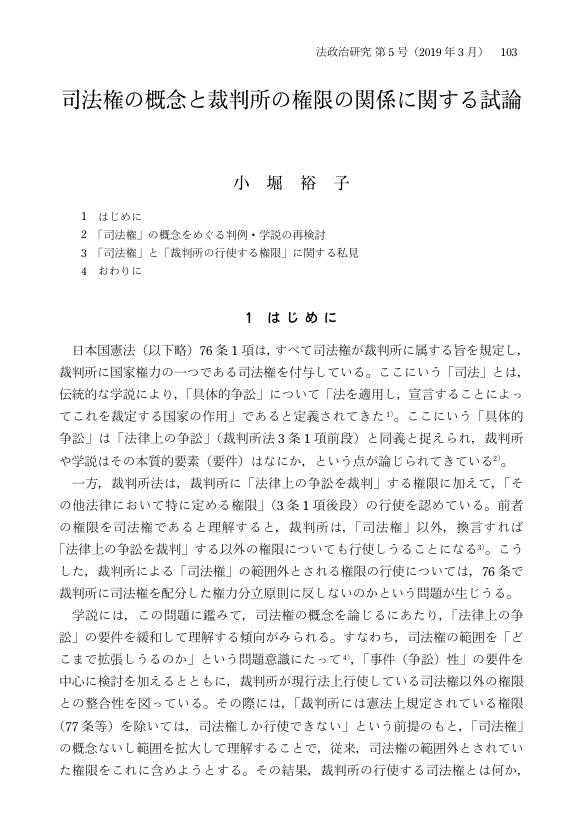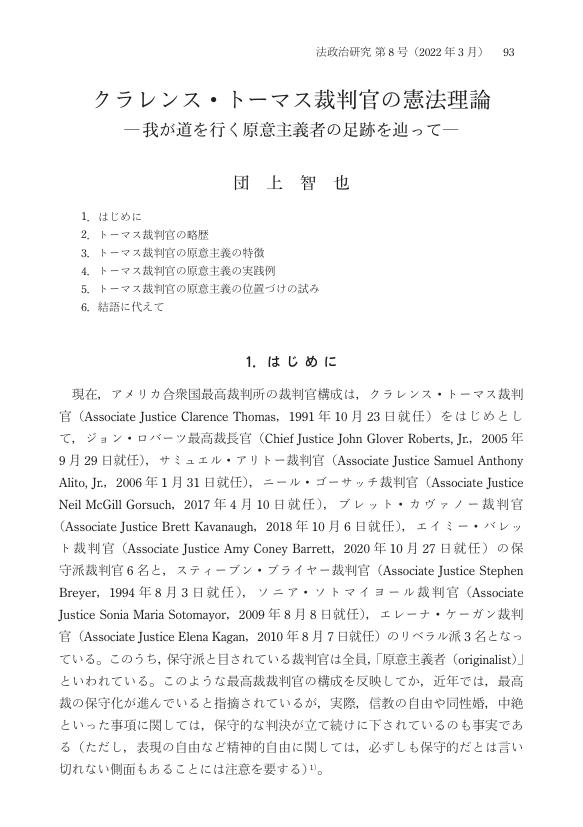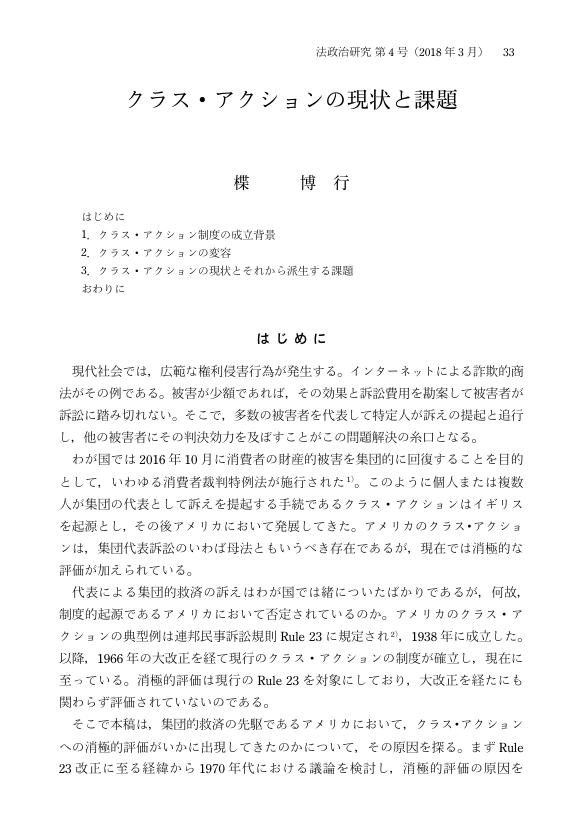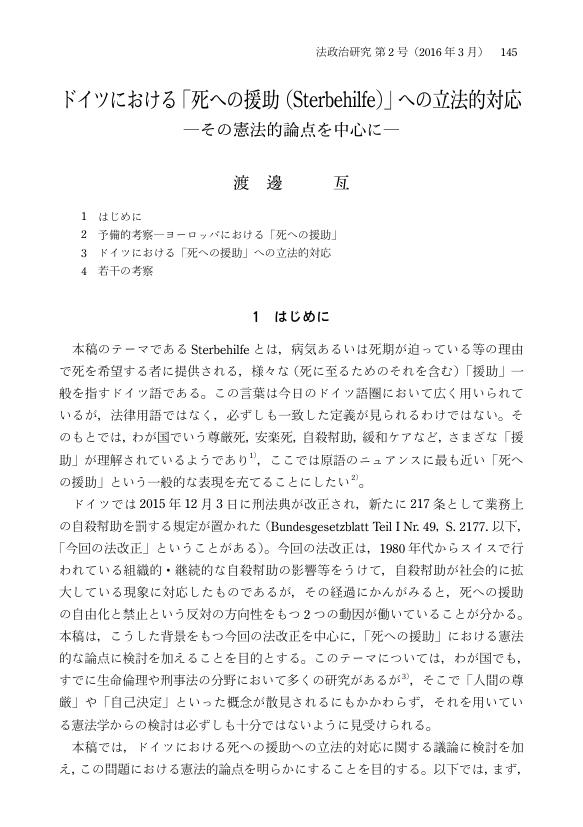42 0 0 0 OA イルカに権利はあるか ―イルカの法的地位と権利―
- 著者
- 山﨑 将文
- 出版者
- 関西法政治研究会
- 雑誌
- 法政治研究 (ISSN:21894124)
- 巻号頁・発行日
- vol.6, pp.121, 2020 (Released:2020-06-01)
17 0 0 0 OA 「象徴」の由来,受容および普及をめぐって ―日本特有「二権分立制」の再生―
- 著者
- 下條 芳明
- 出版者
- 関西法政治研究会
- 雑誌
- 法政治研究 (ISSN:21894124)
- 巻号頁・発行日
- vol.3, pp.19, 2017 (Released:2017-05-26)
16 0 0 0 OA ドイツにおける難民政策の課題とその憲法的意義
- 著者
- 渡邊 亙
- 出版者
- 関西法政治研究会
- 雑誌
- 法政治研究 (ISSN:21894124)
- 巻号頁・発行日
- vol.3, pp.123, 2017 (Released:2017-05-26)
14 0 0 0 OA 憲法硬性度は憲法改正に影響を与えるか ―憲法制度と憲法政策の総合研究―
- 著者
- 北村 貴
- 出版者
- 関西法政治研究会
- 雑誌
- 法政治研究 (ISSN:21894124)
- 巻号頁・発行日
- vol.4, pp.85, 2018 (Released:2018-05-28)
13 0 0 0 OA 請願権と地方議会
- 著者
- 林 紀行
- 出版者
- 関西法政治研究会
- 雑誌
- 法政治研究 (ISSN:21894124)
- 巻号頁・発行日
- vol.5, pp.27, 2019 (Released:2019-06-08)
9 0 0 0 OA 憲法の効力と解釈に関する一考察 ―占領・独立・憲法事実―
- 著者
- 東 裕
- 出版者
- 関西法政治研究会
- 雑誌
- 法政治研究 (ISSN:21894124)
- 巻号頁・発行日
- vol.3, pp.43, 2017 (Released:2017-05-26)
9 0 0 0 OA 皇位継承の憲法政治学的考察 ―「皇室の自律の再構成」という試論―
- 著者
- 渡邊 亙
- 出版者
- 関西法政治研究会
- 雑誌
- 法政治研究 (ISSN:21894124)
- 巻号頁・発行日
- vol.4, pp.113, 2018 (Released:2018-05-28)
7 0 0 0 OA 災害時における地方議会の役割
- 著者
- 林 紀行
- 出版者
- 関西法政治研究会
- 雑誌
- 法政治研究 (ISSN:21894124)
- 巻号頁・発行日
- vol.6, pp.53, 2020 (Released:2020-06-01)
6 0 0 0 OA 司法権の概念と裁判所の権限の関係に関する試論
- 著者
- 小堀 裕子
- 出版者
- 関西法政治研究会
- 雑誌
- 法政治研究 (ISSN:21894124)
- 巻号頁・発行日
- vol.5, pp.103, 2019 (Released:2019-06-08)
5 0 0 0 OA 西欧における「記憶法」の分析 ―公正世界仮説による「記憶法」への影響―
- 著者
- 田上 雄大
- 出版者
- 関西法政治研究会
- 雑誌
- 法政治研究 (ISSN:21894124)
- 巻号頁・発行日
- vol.6, pp.97, 2020 (Released:2020-06-01)
- 著者
- 青木 望美
- 出版者
- 関西法政治研究会
- 雑誌
- 法政治研究 (ISSN:21894124)
- 巻号頁・発行日
- pp.45-78, 2015
Great East Japan Earthquake (March 11, 2011) resulted in the serious accident of Fukushima I Nuclear Power Plant. Since this gave rise to the influential possibilities of radiation exposure, Japanese government ordered a series of evacuation instructions. This article aims to examine the significance of all the reaction related to the spatial establishment, made allowance for the fact that the radioactivity in evacuation zone entails necessarily the influence on human being as well as environment itself. Concretely first the establishment and reorganization of evacuation zone will be arranged in chronological order, thereafter argument regarding a criterion of the low level radiation will be outlined. Second comparing to so-called Chernobyl Law as a similar case in Fukushima Pref., Japanese state-practice will be relativized to the recommendation of the UN special rapporteur. Finally the individual reaction in the outer areas of evacuation zone in terms of the low level radiation will be examined.
4 0 0 0 OA いわゆる「部分社会の法理」の再構成
- 著者
- 渡邊 亙
- 出版者
- 関西法政治研究会
- 雑誌
- 法政治研究 (ISSN:21894124)
- 巻号頁・発行日
- vol.First, pp.229-264, 2015-03-29 (Released:2017-07-06)
Die in Deutschland unter dem Thema "Selbstverwaltung" behandelte Frage wird in Japan in zwei wesentlich unterschiedlichen dogmatischen Bereichen betrachtet. Die hier zu behandelnde Lehre, welche die Autonomie der nicht kommunalen Korperschaften zum Gegenstand hat, wird in Japan als Lehre der "Teilgesellschaft" bezeichnet. Der Begriff "Teilgesellschaft" stammt urspriinglich aus dem rechtsphilosophischen Kontext. Heute bildet dieser Begriff den Kern der Lehre der Rechtsprechung uber die Autonomie der Korperschaften im offentlichen und privaten Bereich. In der folgenden Untersuchung ist zunachst die Entwicklung dieses Begriffs in Literatur und Rechtsprechung zu beschreiben. Anschliessend soil auf ihre Charakteristika sowie die daraus folgende Problematik hingewiesen werden.
4 0 0 0 OA クラレンス・トーマス裁判官の憲法理論 ―我が道を行く原意主義者の足跡を辿って―
- 著者
- 団上 智也
- 出版者
- 関西法政治研究会
- 雑誌
- 法政治研究 (ISSN:21894124)
- 巻号頁・発行日
- vol.8, pp.93, 2022 (Released:2022-06-17)
4 0 0 0 OA 日本における憲法硬性度はどの程度の高さか ―改正手続に基づく定量指標の形成と国際比較―
- 著者
- 北村 貴
- 出版者
- 関西法政治研究会
- 雑誌
- 法政治研究 (ISSN:21894124)
- 巻号頁・発行日
- vol.3, pp.69, 2017 (Released:2017-05-26)
4 0 0 0 OA 阿倍内親王の「立太子」前後
- 著者
- 大友 裕二
- 出版者
- 関西法政治研究会
- 雑誌
- 法政治研究 (ISSN:21894124)
- 巻号頁・発行日
- vol.5, pp.123, 2019 (Released:2019-06-08)
3 0 0 0 OA クラス・アクションの現状と課題
- 著者
- 楪 博行
- 出版者
- 関西法政治研究会
- 雑誌
- 法政治研究 (ISSN:21894124)
- 巻号頁・発行日
- vol.4, pp.33, 2018 (Released:2018-05-28)
- 著者
- 渡邊 亙
- 出版者
- 関西法政治研究会
- 雑誌
- 法政治研究 (ISSN:21894124)
- 巻号頁・発行日
- vol.2, pp.145, 2016 (Released:2016-12-26)
3 0 0 0 OA 教育委員会制度改革とその課題
- 著者
- 林 紀行
- 出版者
- 関西法政治研究会
- 雑誌
- 法政治研究 (ISSN:21894124)
- 巻号頁・発行日
- vol.3, pp.1, 2017 (Released:2017-05-26)
3 0 0 0 OA 本会議趣旨説明要求 ―衆議院における運用経緯と制度の再定位―
- 著者
- 南部 義典
- 出版者
- 関西法政治研究会
- 雑誌
- 法政治研究 (ISSN:21894124)
- 巻号頁・発行日
- vol.2, pp.63, 2016 (Released:2016-12-26)
3 0 0 0 OA 会社の営利性に関する一考察
- 著者
- 吉田 夏彦
- 出版者
- 関西法政治研究会
- 雑誌
- 法政治研究 (ISSN:21894124)
- 巻号頁・発行日
- vol.2, pp.119, 2016 (Released:2016-12-26)

















